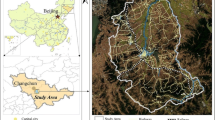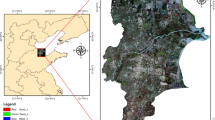Abstract
Protecting the ecological environment is an important goal of the world sustainable development. Rapid and quantitative evaluation of regional ecological environment is the technical support and necessary condition for this goal. The ecological environment index model (RSEI) which used to assess ecological environment is the most popular now. But it changed into two completely opposite models in the application. Most researchers choose which model to use based on the desired results. This article concludes the reason by studying the operating mechanism of the model and finds that it is the eigenvector direction in the principal component analysis causes this to happen. Taking Pingyu County as an example, this article calculates RSEI with Landsat 8 images in different periods in Google Earth Engine using the two existing models respectively and finds that two models show two opposite result trends in spatial distribution. Using any model to calculate the same image, the results are also opposite if changing the input order of the indicators. It is the eigenvector direction determines the spatial distribution by comparing and analyzing the eigenvector of each image and its corresponding RSEI. Then, this paper improves the model by fixing the eigenvector direction based on the actual effects on ecological environment of the four indicators, taking absolute values of the eigenvectors of NDVI and Wet which have a positive effect on the ecological environment and the opposite of absolute values of the eigenvectors of LST and NDSI which have a negative effect on the ecological environment, in order to improve the RSEI model. Using the improved model calculate each image, the results are consistently accurate. Furthermore, this paper also proposed a model for users who calculating the principal components through software where the eigenvector direction cannot be altered artificially. This paper proposes the improved model which is suitable for all users whether using software or conducting programming. The improved model is suitable for all images of any input order of the indicators. It provides the possibility of applying remote sensing big data to the ecological environment. At the same time, the study of the mechanism of the model provides a scientific basis for future scholars to calculate in batches.





Similar content being viewed by others
References
Basta JD, Bower TB (1982) Analyzing natural systems. A research paper from resources for the future. The Johns Hopkings University Press, Baltimore
Chang ZB, Qin F (2017) Dynamic evaluation of eco-environmental quality in He’nan province based on RS and GIS. Water Soil Conserv Bull 037.004(2017):132–137
Changon SA, Semonim RG (1979) Impact of man upon local and regional weather. Rev Geophys Space Phys 17:1891–1900
Crist EP (1985) A TM tasseled cap equivalent transformation for reflectance factor data. Remote Sens Environ 17:301–306
Cui F (2013) Land use change and eco-environmental response in urban fringe. Nanjing Agricultural University
Cui J, Zang SW (2013) Ecological environment effect of land use change in Hadaqi industrial corridor. Geogr Res 2:848–856
Di Gregorio A, Jansen LJM (2000) Land cover classification system (LCCS): classification concepts and user manual. http://www.fao.org/3/y7220e/y7220e00.htm
Du X, Huang Z (2017) Ecological and environmental effects of land use change in rapid urbanization: the case of Hangzhou, China. Ecol Indic 8:243–251
Guo XD, Chen LD, Fu BJ (1999) Impact of land use/land cover change on regional ecological environment. Environ Eng 6:66–75
Han W, Cui JQ, Bin C (2013) Analysis of wetland dynamics and its influencing factors in Northeast China. J Basic Sci Eng 21:214–223
Han RD, Zhang L, Zheng Y et al (2017) Eco-environmental effects of urban expansion in Bangkok. Acta Zool 37:6322–6334
Jang H (2017) Study on land use change and its eco-environmental effects in Xijiang River basin of Guangxi. Guangxi Normal University
Jiménez-Muñoz JC, Cristóbal J, Sobrino JA et al (2009) Revision of the single-channel algorithm for land surface temperature retrieval from Landsat thermal-infrared data. IEEE Trans Geosci Remote Sens 47:339–349
Li XW, Fang JY, Piao SL (2003) Land use change and its ecological environment effect in the lower reaches of the Yangtze River in recent 10 years. J Geogr 58:659–667
Liu ZC, Xu HQ, Li L (2015) Urban ecological change in Hangzhou city based on remote sensing ecology index. J Appl Basic Eng Sci 4:728–739
Li CH et al (2016) Land use and cover change (LUCC) in traditional agricultural areas and its eco-environmental effects. J Southwest Univ (Nat Sci Ed) 38:139–145
Li QY, Wang ZX, Cui J (2018) Study on RSEI classification of eco-environmental quality index of Aksu city based on TM data. Tianjin Agric Sci 24(67-71):90
Liao LH, Dai WY, Huang HF (2018) Coupling and coordination analysis of urbanization and eco-environment based on DMSP/OLS and Landsat data. J Fujian Norm Univ (Nat Sci Ed) 34:99–108
Liu P, Ren CY, Wang ZM (2018a) Remote sensing evaluation of ecological environment quality in Nanwenghe Nature Reserve. J Appl Ecol 29:191–200
Liu Y, Yue H, Meng JX, Zhang F, Cui QP (2018b) Remote sensing assessment of the ecological environment of major cities in China section of the Silk Road economic belt. Environ Monit Manag Technol 30:35–39+48
Man S, Nu Y (2010) Oasis cultivated land change and river hydrological effect in Tarim river basin. Geogr Res 25(12):2251–2260
Shan W, Jin XB, Meng XS (2019) Dynamic monitoring of ecological environment quality in land improvement based on multi-source remote sensing data. J Agric Eng 35:242–250
Sobrino JA, Jiménez-Muñoz JC, Sòria G et al (2008) Land surface emissivity retrieval from different VNIR and TIR sensors. IEEE Trans Geosci Remote Sens 46:316–327
Song HM, Xue L (2016) Dynamic monitoring and analysis of ecological environment quality in Weinan city based on remote sensing ecological index model. J Appl Ecol 27:3913–3919
Song MJ, Luo YY, Duan LM (2019) Evaluation of ecological environment in the Xilin Gol steppe based on modified remote sensing ecological index model. Arid Zone Res 6:1521–1527
State Environmental Protection Administration. Environmental Protection Industry Standards of the People’s Republic of China (Trial Implementation). HJ/T192-2006
UN (2015) Transforming Our World: The 2030 Agenda for Sustainable Development. United Nations, New York
Wang H, Qin F, Zhu J, Zhang CC (2017) Impact of land use and landscape patterns evolution on ecosystem service Value. Acta Zool 3:1286–1296
Wang JH, Liang L, Huang T et al (2018) Land use change and its ecological environment effects in Xuzhou City. Bull Soil Water Conserv
Xu HQ (2005) Study on extracting water information by improved normalized difference water index (MNDWI). J Remote Sens 9:589–595
Xu HQ (2013a) Establishment and application of urban remote sensing ecological index. J Ecol 33:7853–7862
Xu HQ (2013b) Remote sensing evaluation index of regional eco-environmental change. Environ Sci China 33:889–897
Xu HQ, Shi TT, Wang MY (2017) Prediction of land cover change and ecological response to new area planning in Xiongan new area. J Ecol 37:6289–6301
Yang FH, Song JJ, Zhao YR (2018) Remote sensing dynamic monitoring of ecological environment in black soil erosion area of Northeast China. Environ Sci Res:1580–1587
Yang JY, Wu T, Pan XY, Du HT, Li JL, Zhang L, Men MX, Chen Y (2019) Ecological quality assessment of Xiongan new area based on remote sensing ecological index. J Appl Ecol 11:1–12
Yu JSD, Chen YJ, Tong RJ (2018) The calculation and application of remote sensing ecological index based on Web interoperability. J Guizhou Univ (Nat Sci Ed) 35:47–53
Yue A, Zhang Z (2018) Analysis and research on ecological situation change based on EI value. Green Sci Technol 14:182–184
Zhang H (2017) Ecological change analysis of Nanjing city based on remote sensing ecological index. Geospatial Information
Zhang BW (2018) Eco-environmental quality evaluation and system design based on RSEI model. Zhengzhou University
Zhang Y, Wang ZF, Chen N et al (2017a) Spatial and temporal variation characteristics and influencing factors of ecological environment in Hubei Province. Environ Sci Technol S2
Zhang H, Du PJ, Luo JQ (2017b) Ecological change analysis of Nanjing city based on remote sensing eco-index. Geospatial Information
Zhang NM, Chen DH, Xing F (2019) Ecological change analysis of Bole city in arid region of Xinjiang based on remote sensing eco-index. Soil Water Conserv Bull 39:154–159 166
Zhao CP, Gong JG, Wang H et al (2018) Evaluation of ecological environment in Huangshui basin based on remote sensing. Rural Water Resources and Hydropower in China
Zheng Y (2014) Extraction and change analysis of eco-environmental index based on TM data. Nanjing Forestry University
Zhu HX, Jia Y, Hou HP (2006) Impact of land use change on ecosystem service value: a case study of Xuzhou. Sci Technol Manag Land Res 23:97–99
Acknowledgments
Special thanks to The Key Laboratory of Geospatial Technology for the Middle and Lower Yellow River Regions and National Science & Technology Infrastructure of China, Data Center of Lower Yellow River Regions, National Earth System Science Data Sharing Infrastructure, and National Science & Technology Infrastructure of China (http://henu.geodata.cn).
Author information
Authors and Affiliations
Corresponding author
Additional information
Responsible Editor: Biswajeet Pradhan
Rights and permissions
About this article
Cite this article
Ning, L., Jiayao, W. & Fen, Q. The improvement of ecological environment index model RSEI. Arab J Geosci 13, 403 (2020). https://doi.org/10.1007/s12517-020-05414-7
Received:
Accepted:
Published:
DOI: https://doi.org/10.1007/s12517-020-05414-7




